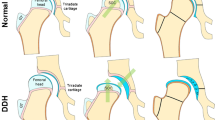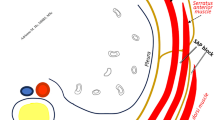Abstract
Background
Shielding of the gonads is a dose-saving strategy in pediatric radiography and its use is the law in New York and the majority of other states. However, routine use of gonadal shields is controversial because of concerns that important diagnostic information can be obscured.
Objective
The purpose of this study was to assess the frequency and spatial distribution of key findings on portable neonatal abdominal radiographs.
Materials and methods
We reviewed the 2,544 portable neonatal intensive care unit anteroposterior abdominal radiographs performed in 2010 at a university medical center, of which 962 were inadequately shielded. These 962 radiographs were reviewed by pairs of pediatric radiologists for the presence of findings in different regions, including bowel abnormalities, pneumatosis, free air, inguinal hernias, osseous abnormalities, and catheter/tube tips.
Results
The fewest pertinent findings were present below the level of the sacrosciatic notches (n = 181, 18.8%). Of the 853 abnormalities below the level of the iliac crests in our cohort, six were isolated to these regions, whereas others had concomitant abnormalities more superiorly. Of 35 radiographs with pneumatosis or suspected pneumatosis in the pelvis, 33 had pneumatosis in more superior regions. Suspected free air was never isolated to the pelvis. Osseous abnormalities were only present in the pelvis below the sacrosciatic notch, and 37.5% of lower extremity catheters terminated below the level of the sacrosciatic notches.
Conclusion
Pertinent findings on neonatal intensive care unit abdominal radiographs are rarely isolated to the pelvic regions.


Similar content being viewed by others
References
Bogdanich J, Rebelo K (2011) X-rays and unshielded infants. New York Times. http://www.nytimes.com/2011/02/28/health/28radiation.html?_r=1&pagewanted=all. Accessed 10 Oct 2012
New York State Department of Health, New York State Public Health Law, section 225, part 16. http://www.health.ny.gov/environmental/radiological/radon/radioactive_material_licensing/docs/part16.pdf. Accessed 06 March 2012
Alaska Department of Health and Social Services (2009) 7 AAC 18. Radiation sources and radiation protection. http://hss.state.ak.us/apps/publicnotice/RegulationDetails.aspx?Regulation=294e103b-3d55-48c0-8ae3-3c91f639e372. Accessed 09 February 2013
Arizona Radiation Regulatory Agency (2010) Arizona administrative code, Title XII natural resources, chapter 1: radiation regulation agency. http://www.azsos.gov/public_services/Title_12/12-01.pdf. Accessed 10 February 2013
Arkansas State Board of Health (2012) Rules and regulations for control of ionizing radiation. http://www.healthy.arkansas.gov/aboutadh/rulesregs/ionizingradiation.pdf. Accessed 10 February 2013
California Code of Regulations (1988) Title 26: toxics. https://law.resource.org/pub/us/ccr/gov.ca.oal.title26.html. Accessed 09 February 2013
Colorado Department of Public Health and Environment, Hazardous Materials and Waste Management Division (2009) 6 CCR 1007–1, State Board of Health, Rules and regulations pertaining to radiation control, part 6. http://www.sos.state.co.us/CCR/Upload/NoticeOfRulemaking/ProposedRuleAttach2009-00806.DOC. Accessed 09 February 2013
Delaware Department of Health and Human Services, Authority on Radiation Protection (2002) Radiation machine registration permit manual. http://dhss.delaware.gov/dph/hsp/files/orcradmacman.pdf. Accessed 10 February 2013
Florida Department of Health (2007) Florida administrative code, part V, X-rays in the healing arts. http://www.floridashealth.com/Environment/radiation/regs/64PART5-08-16-2007.doc. Accessed 09 February 2013
Georgia Secretary of State (1989) Rules and regulations of the State of Georgia, section 290-5-22-.04. X-rays in the healing arts. http://rules.sos.state.ga.us/docs/290/5/22/04.pdf. Accessed 10 February 2013
Hawaii Department of Health (1999) Hawaii administrative rules, chapter 45 of title 11, radiation control. http://gen.doh.hawaii.gov/sites/har/AdmRules1/11-45.pdf. Accessed 10 February 2013
Idaho Department of Health and Welfare (1998) Idaho radiation control rules, 16.02.27. http://adminrules.idaho.gov/rules/current/16/0227.pdf. Accessed 10 February 2013
Illinois Emergency Management Agency (2008) Illinois administrative code, title 32: energy chapter II: Illinois emergency management agency subchapter B: radiation protection part 360: use of X-rays in the healing arts including medical, dental, podiatry, and veterinary medicine. http://www.state.il.us/iema/legal/pdf/32_360.pdf. Accessed 10 February 2013
Indiana State Department of Health (1988) Indoor and radiologic health, radiation machine compliance, rule 6.1. X-rays in the healing arts. http://www.in.gov/isdh/24369.htm. Accessed 09 February 2013
Iowa Department of Public Health. (2013) Chapter 41: Safety requirements for the use of radiation machines and certain uses of radioactive materials. https://www.legis.iowa.gov/DOCS/ACO/IAC/LINC/Chapter.641.41.pdf. Accessed 31 March 2013
Kansas Department of Health and Environment (2005) Radiation control program regulations, part 5. Use of X-rays in the healing arts. http://www.kdheks.gov/radiation/download/2A003_28KDHE_Article_35_2009_KAR_Vol_2A.pdf. Accessed 10 February 2013
Kentucky Legislature (1992) Kentucky administrative regulations, diagnostic X-ray. http://www.lrc.state.ky.us/kar/902/100/115.htm. Accessed 10 February 2013
Louisiana Department of Environmental Quality (2012) Louisiana administrative code, title 33 environmental regulatory code, part XV, radiation protection. http://www.deq.louisiana.gov/portal/Portals/0/planning/regs/title33/33v15-201211.pdf. Accessed 10 February 2013
Maine Department of the Secretary of State, Bureau or Corporations, Elections, and Commissions (2010) State agency rules part F, X-rays in the healing arts. http://www.maine.gov/sos/cec/rules/10/144/ch220/144c220f.doc. Accessed 09 February 2013
Maryland Department of the Environment (1994) Code of Maryland regulations 26.12.01.01. http://www.mde.state.md.us/programs/Air/RadiologicalHealth/RegulationsforControlofIonizingRadiation/Documents/www.mde.state.md.us/assets/document/air/RH_comar/regs_final_new.pdf. Accessed 11 February 2013
Massachusetts Executive Office of Health and Human Services (2012) Regulations 120.400 X-rays in the healing arts. http://www.mass.gov/eohhs/docs/dph/regs/105cmr120-400.rtf. Accessed 09 Feb 2013
Michigan Department of Licensing and Regulatory Affairs, Radiation Safety Section (1975) Ionizing radiation rules, part 8: medical extremity X-ray installations. http://michigan.gov/documents/bhs_irr_part8_141985_7.pdf. Accessed 09 February 2013
Revisor of Statutes, State of Minnesota (2009) Minnesota administrative rules, chapter 4732, ionizing radiation. https://www.revisor.leg.state.mn.us/rules/?id=4732.0510&format=pdf. Accessed 10 February 2013
Mississippi State Department of Health, Division of Radiological Health (2012) Part 21 subpart 78: radiological health. http://www.msdh.state.ms.us/msdhsite/_static/resources/4620.pdf. Accessed 11 February 2013
Montana Department of Public Health and Human Services (2000) Radiation control, X-rays in the healing arts, rule 37.14.1006. http://www.mtrules.org/gateway/ruleno.asp?RN=37.14.100. Accessed 10 February 2013
Nebraska Health and Human Services System (2004) Nebraska administrative code title 180, 6 diagnostic X-rays other than dental radiation generating equipment in the healing arts. http://www.sos.state.ne.us/rules-and-regs/regsearch/Rules/Health_and_Human_Services_System/Title-180/Chapter-06.pdf. Accessed 11 Feb 2013
Nevada Legislature (1980) Nevada administrative code, chapter 459: hazardous materials. http://www.leg.state.nv.us/nac/nac-459.html#NAC459Sec448. Accessed 10 February 2013
The New Hampshire General Court (2011) New Hampshire rules for the control of radiation. He-P 4045–03, administrative controls. http://www.gencourt.state.nh.us/rules/state_agencies/he-p4040-4047.html. Accessed 13 February 2013
New Jersey Department of Environmental Protection (2002) Compliance guidance for quality assurance manual, 2nd edition. http://www.state.nj.us/dep/rpp/qa/qa_down/qaman.pdf. Accessed 10 February 2013
New Mexico Secretary of State (2001) New Mexico administrative code, title 20 environmental protection, chapter 3 radiation protection, part 6 X-rays in the healing arts. http://www.nmcpr.state.nm.us/nmac/parts/title20/20.003.0006.htm. Accessed 09 February 2013
North Carolina Department of Environment and Natural Resources (2002) North Carolina regulations for protection against radiation. http://www.ncradiation.net/regs/15ancac11_1006.pdf. Accessed 10 February 2013
North Dakota Department of Health (2003) Radiation control, regulation chapter 33-10-06: X-rays in the healing arts. http://www.ndhealth.gov/aq/rad/radrules/33-10-06.pdf. Accessed 10 February 2013
Ohio Administrative Code (2005) Chapter 3701:1–66 radiation generating equipment. http://codes.ohio.gov/oac/3701%3A1-66. Accessed 09 February 2013
Oklahoma State Department of Health (2010) Oklahoma administrative code 310, chapter 281, diagnostic X-ray systems. http://www.ok.gov/health2/documents/CPD.Diagnostic%20X-Ray%20Systems%20Title310.Chapter281.pdf. Accessed 11 February 2013
Oregon Health Authority, Public Health Division (1991) Division 106, X-rays in the healing arts. http://arcweb.sos.state.or.us/pages/rules/oars_300/oar_333/333_106.html. Accessed 09 February 2013
The Pennsylvania Code (1987) Chapter 221, X-rays in the healing arts. http://www.pacode.com/secure/data/025/chapter221/chap221toc.html. Accessed 09 February 2013
State of Rhode Island and Providence Plantations Department of Health (2007) Rules and regulations for the control of radiation [R23-1.3-Rad]. http://sos.ri.gov/documents/archives/regdocs/released/pdf/DOH/4864.pdf. Accessed 11 February 2013
South Carolina Department of Health and Environmental Control (2009) X-ray regulations No. 61–64 - Title B - Rules and regulations for radiation control, part IV. Use of X-ray in the health professions. http://www.scdhec.gov/health/radhlth/part04.pdf. Accessed 11 Feb 2013
South Dakota Legislature (2010) Administrative rules, 44:03:01:10.01. Requirements for personal protective devices. http://legis.state.sd.us/rules/DisplayRule.aspx?Rule=44:03:01:10.01. Accessed 11 February 2013
Tennessee Department of Environment and Conservation Division of Radiological Health (2012) Rules chapter 0400-20-06. Use of X-ray apparatus. http://www.tn.gov/sos/rules/0400/0400-20/0400-20-06.20120522.pdf. Accessed 11 February 2013
Texas Department of State Health Services (2004) Radiation control program, use of radiation machines in the healing arts (Texas administrative code 289.227). http://www.dshs.state.tx.us/radiation/rules.shtm. Accessed 11 February 2013
Utah Department of Administrative Services (2013) Utah administrative code, rule R313-28, use of X-rays in the healing arts. http://www.rules.utah.gov/publicat/code/r313/r313-028.htm. Accessed 09 February 2013
Vermont Department of Health (2010) Vermont radiological health statute and regulations, part 5, chapter 3 radiological health, subchapter 1 radiation protection. http://healthvermont.gov/regs/documents/radio_health_amended_rule.pdf. Accessed 11 February 2013
Virginia Department of Health (2008) Commonwealth of Virginia radiation protection regulations. http://www.vdh.state.va.us/epidemiology/radiologicalhealth/index.htm. Accessed 09 February 2013
Washington State Legislature (2008) Washington administrative code, chapter 246–225, radiation protection. X-rays in the healing arts. http://apps.leg.wa.gov/WAC/default.aspx?dispo=true&cite=246-225&full=true. Accessed 09 February 2013
District of Columbia Department of Health (2012) State regulations for the control of radiation, diagnostic X-rays and imaging systems in the healing arts – part F. http://doh.dc.gov/service/suggested-state-regulations-control-radiation. Accessed 11 February 2013
West Virginia Secretary of State (2001) West Virginia radiologic health rule. http://apps.sos.wv.gov/adlaw/csr/readfile.aspx?DocId=8399&Format=PDF. Accessed 11 February 2013
Wisconsin Department of Health Services (2006) X-ray device registration surveys and inspection, subchapter VII. http://www.dhs.wisconsin.gov/radiation/license/Xray/SubChptrs/Subchapter%20VIII.pdf. Accessed 09 February 2013
Code of Federal Regulations (2012) Title 21, volume 8, chapter I, subchapter J, part 1000. http://www.accessdata.fda.gov/scripts/cdrh/cfdocs/cfcfr/CFRSearch.cfm?fr=1000.50. Accessed 09 February 2013
Frayre AS, Torres P, Gaona E et al (2012) Radiation dose reduction in a neonatal intensive care unit in computed radiography. Appl Radiat Isotopes 71:57–60
Suleiman OH (2004) Radiation doses in pediatric radiology: influence of regulations and standards. Pediatr Radiol 3:S242–S246
Hall EJ (2002) Lessons we have learned from our children: cancer risks from diagnostic radiology. Pediatr Radiol 32:700–706
Wrixon AD (2008) New ICRP recommendations. J Radiol Prot 28:161–168
Fawcett SL, Barter SJ (2009) The use of gonad shielding in paediatric hip and pelvis radiographs. The Brit J Radiol 82:363–370
Pierce DA, Shimizu Y, Preston DL et al (1996) Studies of the mortality of atomic bomb survivors. Report 12, Part I. Cancer: 1950–1990. Radiat Res 146:1–27
Hodges PC, Strandjord NM, McCrea A (1958) A testicular shield. J Am Med Assoc 167:1239–1240
Brindhaban A, Al-Khalifah K (2004) Radiation dose to premature infants in neonatal intensive care units in Kuwait. Radiat Prot Dosimetry 111:275–281
Makri T et al (2006) Radiation risk assessment in neonatal radiographic examinations of the chest and abdomen: a clinical and Monte Carlo dosimetry study. Phys Med Biol 51:5023–5033
Sikand M, Stinchcombe S, Livesley PJ (2003) Study on the use of gonadal protection shields during paediatric pelvic X-rays. Ann Roy Coll Surg 85:422–425
Curtis JR (2010) Computed tomography shielding methods: a literature review. Radiol Technol 81:428–436
Hohl C, Mahnken AH, Klotz E et al (2005) Radiation dose reduction to the male gonads during MDCT: the effectiveness of a lead shield. AJR Am J Roentgenol 184:128–130
Price R, Halson P, Sampson M (1999) Dose reduction during CT scanning in an anthropomorphic phantom by the use of a male gonad shield. Brit J Radiol 72:489–494
Sancaktutar AA, Bozkurt Y, Onder H et al (2012) A new practical model of testes shield: the effectiveness during abdominopelvic computerized tomography. J Androl 33:984–989
Willis CE, Slovis TL (2004) The ALARA concept in radiographic dose reduction. Radiol Technol 76:150–152
Willis CE, Slovis TL (2004) The ALARA concept in pediatric CR and DR: dose reduction in pediatric radiographic exams—a white paper conference executive summary. Pediatr Radiol 3:S162–S164
Don S, Goske MJ, John S et al (2011) Image Gently pediatric digital radiography summit: executive summary. Pediatr Radiol 41:562–565
McCarty M, Waugh R, McCallum H et al (2001) Paediatric pelvic imaging: improvement in gonad shield placement by multidisciplinary audit. Pediatr Radiol 31:646–649
Kenny N, Hill J (1992) Gonad protection in young orthopaedic patients. BMJ 304:1411–1413
Graf JL, Caty MG, Martin DJ et al (2002) Pediatric hernias. Semin Ultrasound CT 23:197–200
Bardo DM, Black M, Schenk K et al (2009) Location of the ovaries in girls from newborn to 18 years of age: reconsidering ovarian shielding. Pediatr Radiol 39:253–259
Fawcett SL, Gomez AC, Barter SJ et al (2012) More harm than good? The anatomy of misguided shielding of the ovaries. Brit J Radiol 85:e442–e447
Hutson JM, Balic A, Nation T et al (2010) Cryptorchidism. Semin Pediatr Surg 19:215–224
Conflicts of interest
None.
Author information
Authors and Affiliations
Corresponding author
Rights and permissions
About this article
Cite this article
Winfeld, M., Strubel, N., Pinkney, L. et al. Relative distribution of pertinent findings on portable neonatal abdominal radiographs: can we shield the gonads?. Pediatr Radiol 43, 1295–1302 (2013). https://doi.org/10.1007/s00247-013-2700-7
Received:
Revised:
Accepted:
Published:
Issue Date:
DOI: https://doi.org/10.1007/s00247-013-2700-7




